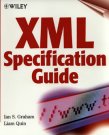THE XML SPECIFICATION GUIDE
Book Outline and Content Description
The XML Specification Guide is divided into three parts. Part one presents a bootstrap overview of XML. Part two contains the complete XML 1.0 specification, with explanatory annotations. Last, Part three contains appendices that (a) describe technical standards (e.g., the Unicode character set) important for understanding important parts of the XML specification, and that (b) introduce some of the evolving, but as-yet incomplete, extensions to the base XML 1.0 standard.
Part 1: XML Overview and Bootstrap
This part contains nine short chapters that introduce all the core concepts and mechanisms of XML, using example documents to illustrate key concepts and issues. The topics covered in the chapters are:
- Chapter 1. A Basic XML Document
- Concepts Covered: prolog, XML declaration,
encoding declaration, start-tag, end-tag,
empty-element tag, comments, entity, well-formed documents,
valid documents
- Chapter 2. Declaring Markup: The Document Type Declaration
- Concepts Covered: Document type declaration, element type declarations,
content models, attribute list declarations, string attribute types, enumerated
list attribute types, internal entities, general entities, entity references,
standalone documents
- Chapter 3. Internal Entities and Character References
- Concepts Covered: Internal general and parameter entities (declarations and
references), character references, entity replacement text
- Chapter 4. Parameter and General Entities
- Concepts Covered: External parsed entities (declarations, general, parameter,
references), text declaration
- Chapter 5. External and Internal Document Type Declaration Subsets
- Concepts Covered: external subset, internal subset, conditional section
- Chapter 6. Unparsed Entities and Tokenized Attribute Types
- Concepts Covered: unparsed entities, notation declarations, entity tokenized
attribute types
- Chapter 7. Notation Attribute Types and Processing Instructions
- Concepts Covered: processing instructions, notation attribute types
- Chapter 8. ID and Name Token Attribute Types
- Concepts Covered: ID, IDREF, and IDREFS attribute types, NMTOKEN and NMTOKENS
attribute types
- Chapter 9. CDATA Marked Sections and Language Identification
- Concepts Covered: language identification, CDATA marked sections
Part 2: The XML Specification
This part contains the complete text of the XML 1.0 specification, including explanatory annotations and examples.
- Chapter 1. Introduction
- Chapter 2. Documents
- Chapter 3. Logical Structures
- Chapter 4. Physical Structures
- Chapter 5. Conformance
- Chapter 6. Notation
- Appendix A. References
- Appendix B. Character Classes
- Appendix C. XML and SGML (Non-Normative)
- Appendix D. Expansion of Entity and Character References (Non-Normative)
- Appendix E. Deterministic Content Models (Non-Normative)
- Appendix F. Autodetection of Character Encodings (Non-Normative)
- Appendix G. W3C XML Working Group (Non-Normative)
Part 3: Technical Appendices
This part of the book contains appendices that (a) describe technical standards (e.g., the Unicode character set) important for understanding important parts of the XML specification, and that (b) introduce some of the evolving, but as-yet incomplete, extensions to the base XML 1.0 standard.
- Annotated Extended Backus-Naur Form (EBNF) for XML
- The complete EBNF for XML, including XML Well-formedness and
validity constraints. This concise appendix contains the complete
technical specification for XML.
- Appendix B. Character Sets, Character Encodings, and Document Character Sets
- A detailed description of the Unicode character set and of the digital encoding of
character data.
- Appendix C. Identifying Languages: RFC 1766
- A description of the Internet RFC document that defines how human languages
are specified in Internet applications.
- Appendix D. XML for HTML Experts
- A brief summary of the most important differences between XML and HTML, written
for the HTML "expert."
- Appendix E. XML Namespaces
- An overview of how namespaces are likely to be supported in a future
version of XML.
- Appendix F. Schema or DTD?
- A description of how XML can itself be used to define a schema for XML documents.
- Appendix G. Layout of Document Type Declarations
- A set of good practices guidelines for laying out XML DTDs for easy reading and
error detection.
- Glossary. A glossary of XML terms.

ISBN 0-471-32753-0
464 Pages
February, 1999
Book
Outline
Wiley Home
Ian's Home
Liam's Home